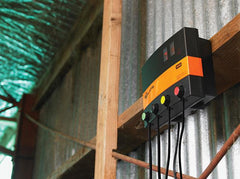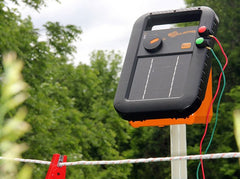Electric Fencing 101: Installation & Troubleshooting Easy Problems
Posted by Gallagher Fencing at
Building stable and secure electric fencing is basically just like building anything else, what you put into it is what you get out of it. By using the appropriate equipment and properly maintaining your electric fence, you’ll have a permanent and safe structure that will last for a very long time.
One key benefit of installing an electric or high-tensile fence is that they’re usually less expensive than installing a barbed wire fence since fewer materials are required as well as less time needed to install them. Also, Gallagher electric fencing is much more versatile by design because you can simple re-install it anywhere you choose. This is especially helpful in times of drought when the pastures fall short and producers need more grazing options.

Overall, an electric fence is considered more of a mental barrier rather than a physical one for virtually every class of cattle or horse. If the livestock are properly trained and the electric fence is working the way it’s supposed to, the animal will only touch the fence once and forever leave it alone. Here are some installation suggestions and equipment tips you should consider in order to get the most out of your electric fence.
1. Purchasing an energizer
 Any equipment that you buy should ideally come from a highly reputable source (like Gallagher Fence, not to toot our own horn), which will ensure that you’re getting only top quality materials. When buying an electric fence energizer, keep in mind that bigger really is better in this case. Try to buy a fence that’s somewhat larger than what you think you’ll need. This will ensure that adequate voltage is running through the wire in order to handle any brush, damp grass, and to also expand in the future if necessary. A general rule of thumb to follow:
Any equipment that you buy should ideally come from a highly reputable source (like Gallagher Fence, not to toot our own horn), which will ensure that you’re getting only top quality materials. When buying an electric fence energizer, keep in mind that bigger really is better in this case. Try to buy a fence that’s somewhat larger than what you think you’ll need. This will ensure that adequate voltage is running through the wire in order to handle any brush, damp grass, and to also expand in the future if necessary. A general rule of thumb to follow:
- No less than 4000 volts is necessary during the winter
- No less than 2000 volts is necessary during the summer
2. Train your livestock to respect your electric fence
 It’s better to train your livestock to respect your electric fence in a somewhat smaller pasture, about 3 or 4 acres. The idea is to shock them just once. In order to pull it off, it may require you to draw the livestock to the electrified wire by fastening ribbon or tinfoil to the wire itself. Usually, most cattle quickly learn to stay clear of a 5000-volt fence once it shocks them and rarely get close to it again. After approximately 3-5 days, all the animals will likely figure out they should avoid the fence altogether. Another practical way to train animals to avoid an electric fence is to utilize electrified corrals throughout the winter feeding times.
It’s better to train your livestock to respect your electric fence in a somewhat smaller pasture, about 3 or 4 acres. The idea is to shock them just once. In order to pull it off, it may require you to draw the livestock to the electrified wire by fastening ribbon or tinfoil to the wire itself. Usually, most cattle quickly learn to stay clear of a 5000-volt fence once it shocks them and rarely get close to it again. After approximately 3-5 days, all the animals will likely figure out they should avoid the fence altogether. Another practical way to train animals to avoid an electric fence is to utilize electrified corrals throughout the winter feeding times.
3. Consider using temporary fencing
 High-tensile, electrified wire can be incorporated as an easy-to-install, economical, portal fencing alternative. This will offer producers more flexibility when it comes to rotational grazing methods in order to break up feeding options and paddocks during times of drought. The Smart Fence 2 is a great option for portable fencing.
High-tensile, electrified wire can be incorporated as an easy-to-install, economical, portal fencing alternative. This will offer producers more flexibility when it comes to rotational grazing methods in order to break up feeding options and paddocks during times of drought. The Smart Fence 2 is a great option for portable fencing.
4. Solar power is a good alternative
 Implementing solar panels is a viable solution for grazing livestock in more remote locations. If you already use solar for your water pumping system in a remote location, you can easily hook your electric fence up to the existing system. (Check out our top solar charger, the S17 if you are interested)
Implementing solar panels is a viable solution for grazing livestock in more remote locations. If you already use solar for your water pumping system in a remote location, you can easily hook your electric fence up to the existing system. (Check out our top solar charger, the S17 if you are interested)
Be sure the solar panel is properly installed and facing the direction of the sun at high noon. Check this by placing a pencil on the panel vertically at noon, at which point there shouldn’t be a shadow. Installed in the correct position, the solar panel will adequately charge the battery which will sufficiently power the fence.
5. Maintaining your electric fence
Some highly useful tools to keep your fence in good working order are a fault finder and a volt meter. The volt meter will ensure that enough voltage is getting delivered regularly, while a fault finder will greatly accelerate the repair process by clearly indicating where the problem lies.
Once in the spring, it’s crucial to walk along your entire fence line in order to ensure that the wire is tight and the insulators are in place. Also, look for any obstructive debris like fallen branches off trees that may potentially decrease the amount of power surging through the wire. If you’re not using your energizer during the winter, be sure to store it in a dry, clean area.
A properly cared for electric fence will offer many years of maintenance-free service and benefits.
Share this post
0 comments

